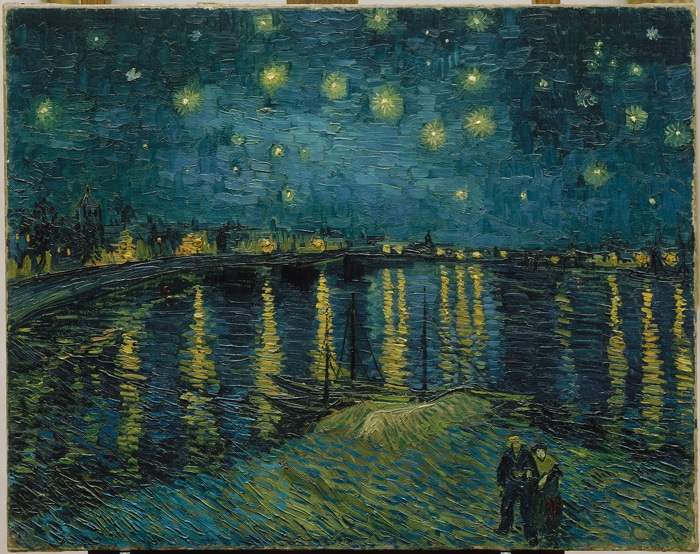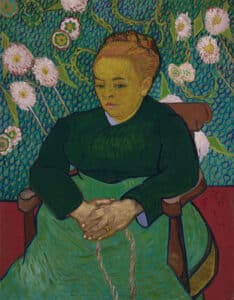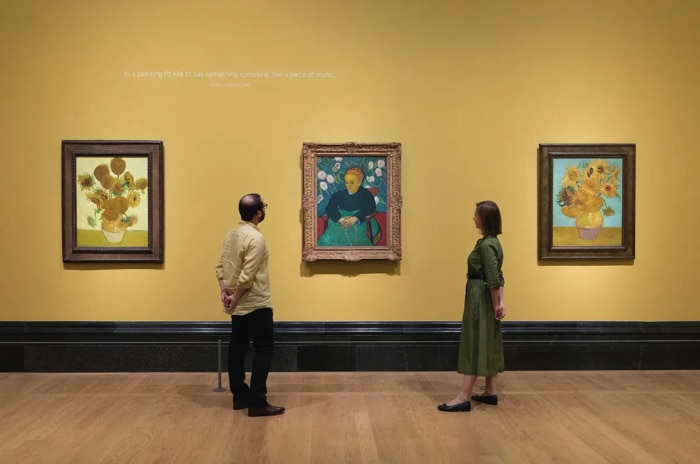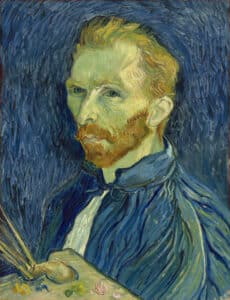




Dir: David Bickerstaff | Prod: Phil Grabsky | UK Art Doc
Exhibition On Screen is a series of documentary portraits of painters and their iconic works. It goes behind the scenes at major galleries and museums – this time London’s National Gallery – offering detailed insight from experts and curators and dramatised scenes that bring the artists to life.
David Bickerstaff and Phil Grabsky already highlighted the Vincent Van Gogh’s letters with his brother Theo,(1853-90) in the 2015 documentary Van Gogh A New Way of Seeing. This time they once again bring the letters to bear with a lyrical look at works from the artist’s most vibrant, less sensational, period when he discovered the power of colour and sunlight during a two-year sejour in the South of France.
Through forty seven paintings and fourteen drawings, the focus here is Van Gogh’s imagination as a visual poet rather than the tragedy of his personal life. The theme of lovers dominates in the opening room with his portrait of “the lover”, lieutenant Paul Milliet, the Zouave regiment soldier who Van Gogh saw as a ladies’ man. The artist was clearly aware of his seductive powers: “Milliet’s lucky, he has all the Arlésiennes he wants, but there you are, he can’t paint them, and if he was a painter he wouldn’t have any.”

La Berceuse 1889

This image is paired with that of the “the poet” – his Belgian artist friend Eugène Boch (Musée d’Orsay, Paris) whom he considered a more sensitive soul, framing him against an azure background of stars. In the middle of these two works is a picture of two embracing lovers strolling through a shady park, in fact the public park opposite the famous yellow house Van Gogh rented in Arles and shared, at one point, with Gauguin during 1888-9 when he painted ‘The Yellow House’, and ‘The Bedroom’.
During this time he also depicted his short spells in the local asylum just outside Saint-Remy-de-Provence. These stays, when he stopped working altogether, enabled Van Gogh to recuperate and recalibrate his emotional state before getting back to work with renewed vigour. Far from the troubled madman he is so often depicted as, this exhibition and film lays bare the artist as a sensitive and deeply poetic soul uniquely able to convey the beauty of his surroundings on canvas.
Central to the exhibition is the spectacular ‘Starry Night over the Rhone’ (main picture) and Self-Portrait further illustrating his successful time in Arles.

With valuable contributions from art specialists and curators: Christopher Riopelle, Lachlan Goodie, The Times’ critic Rachel Campbell Johnson and others, the film also offers a detailed look at detailed marks and brushwork from a selection of rarely seen paintings from private collections all over the world. ‘The Poet’s Garden’, ‘The Trinquetaille Bridge’ and ‘The Public Garden, Arles’.
Poets and Lovers shows how Gogh had started to build his work into a series that could work together. An example of this is the so-called ‘triptych’, with two of the Sunflowers surrounding ‘Madame Roulin Rocking the Cradle’ (La Berceuse) from the Museum of Fine Arts, Boston. The National Gallery owns the ‘Sunflowers’ on a yellow background, which is displayed with one of Van Gogh’s two versions on a blue background, this one on loan from the Philadelphia Museum of Art. All the three paintings are displayed on one wall.
Ironic, then, to think that Van Gogh was unable to sell his work during his lifetime, relying on the financial support of his brother Theo, when Nowadays his paintings go under the hammer for eye-watering amounts of money, even running into the millions.
Enriched with dramatised sequences this is a spectacular film to watch and keeping re-visiting about Van Gogh’s hopeful and productive time in the South of France. @MeredithTaylor
ON RELEASE FROM 6 NOVEMBER 2024